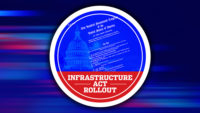The U.S. Dept. of Transportation has released a plan to map out general priorities and hurdles ahead to deal with changing trends in how the country moves its $52 billion in goods and energy products.
[View summary of plan here, and full plan here.]
The National Freight Strategic Plan, which DOT rolled out Sept. 3, identifies the poor condition of freight transportation infrastructure as a problem and calls for “targeted,” but not quantified, financial assistance to address such things as freight bottlenecks.
Speaking during a virtual meeting to release the freight blueprint, DOT Secretary Elaine Chao said, “This plan establishes a clear vision for the future of our nation’s freight transportation system.” She said it was the first-ever U.S. nationwide plan for freight.
The plan, which was mandated by Congress in the 2015 Fixing America’s Surface Transportation, or FAST, Act, lists modernizing freight infrastructure and operations as one of three overarching national strategic goals.
The others are improving the freight network’s safety, security and resilience and supporting innovation in “data, technologies and workforce capabilities" to improve freight transportation performance.
DOT's plan envisions the federal role in the freight arena as including efforts to “modernize or eliminate unnecessary or duplicative regulations” that, for example, hamper freight system efficiency, or slow project delivery.
The report cites poor infrastructure conditions, particularly in highways, bridges and inland waterway locks, as one barrier to improving the flow of freight and recommends targeted financial assistance to deal with the problem.
There already are several types of federal transportation funding for freight-related projects. In fact, the FAST Act established two freight-oriented transportation programs, using federal highway funds: a National Highway Freight Program, with $6.3 billion over five years; and a Nationally Significant Freight and Highway program, authorized at $4.5 billion over five years.
The highway freight program funds are divided among states by formula; the Nationally Significant Freight and Highway Program provides grants to states selected by the DOT. The Trump administration has renamed that the INFRA program.
The new DOT freight report says, “To be effective, federal freight transportation funding needs to be sustained, multimodal, cross-jurisdictional, reliable and specifically dedicated to freight projects.”
DOT says it will use existing federal funding mechanisms such as competitive grants like the INFRA programs to help address freight projects and employ federal dollars as incentives for state and local governments and private-sector freight infrastructure investments.
But DOT’s report doesn’t spell out how much new infrastructure project funding the department recommends to achieve its freight-system improvement goals. The FAST Act didn't specifically request a recommended freight-funding level from DOT.
Congress had asked for the report by December 2017.




Post a comment to this article
Report Abusive Comment